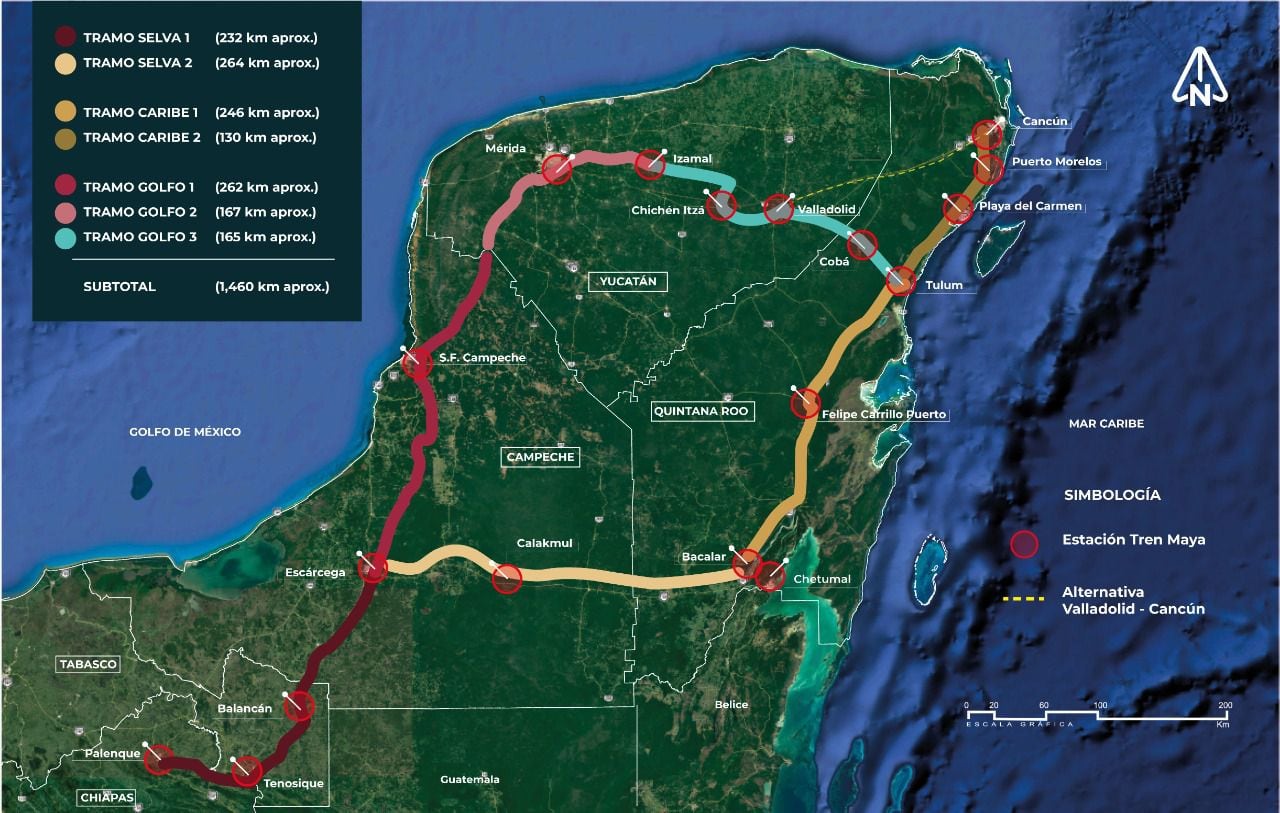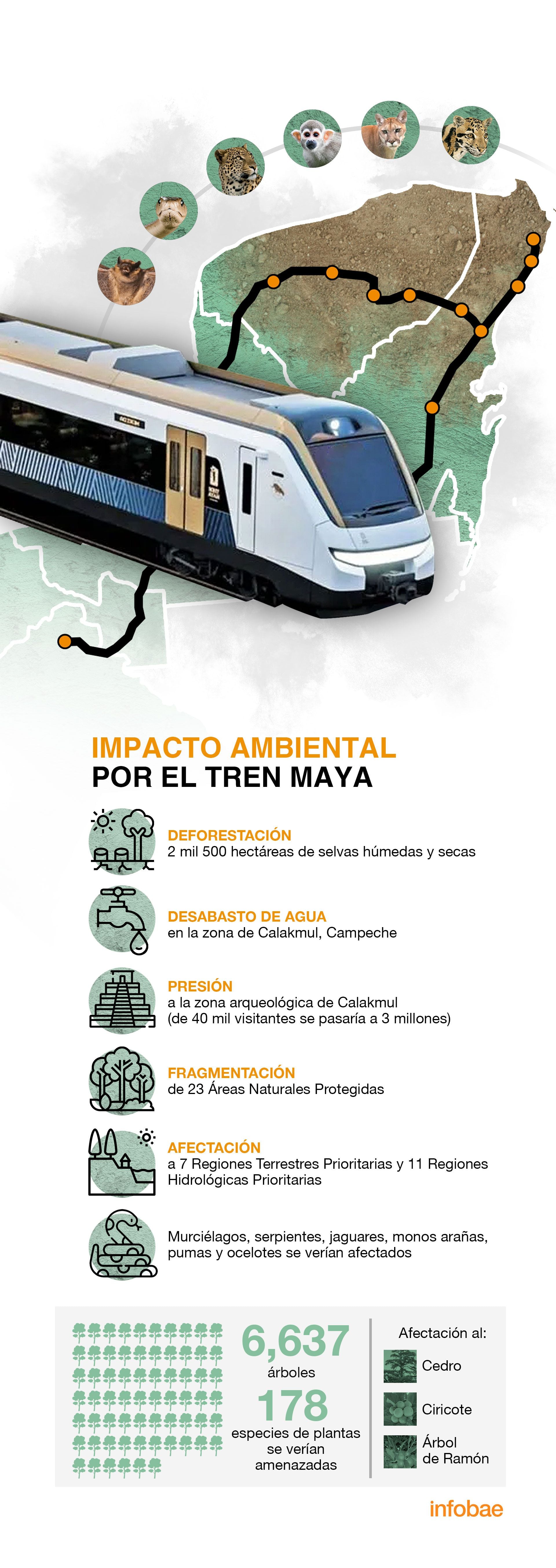:quality(85)/cloudfront-us-east-1.images.arcpublishing.com/infobae/2WABSG6RL5D3XLP5NDZJRAFTFQ.jpg 420w)
The Mayan Train is one of the megaprojects of the administration of President Andrés Manuel López Obrador, with which the aim is to develop the economy and tourism in the southeast of the country, despite the fact that civil organizations have spoken out against its construction. It had an investment of 200 billion pesos and comprises a 1,554 km stretch that will pass through the states of Tabasco, Chiapas, Campeche, Yucatan and Quintana Roo .
According to the description of the project on its website, one of its main axes is economic, since according to official figures there are 7.3 million people living in poverty, of which about 30% are in extreme poverty in the south-southeast region of the country.
“Development has not reached the region in the same way as in the northern and central states of the country,” he explains, so one of the objectives of the Mayan Train is to activate the economy in the southern region, encouraging tourism in the Yucatan Peninsula and in the other entities where the train will pass.
The project comprises 7 sections of construction and is composed of 18 stations and 12 stops. There will also be two types of route: single and double, and three transport services will be offered, one for the local population, one for tourists and another for transporting goods. This would generate jobs in the areas surrounding the construction of the train, known as the “multiplier effect”.

However, civil organizations and members of indigenous communities have spoken out against the project, not only because of the environmental impact it entails, but also because of the impact on the rights of indigenous communities in the region, as well as the risk to historical and cultural heritage.
According to the National Institute of Anthropology and History (INAH), there are 2,288 archaeological sites within 10 kilometers of the railway line that would be directly affected, together with the concentration of tourism and the ecological footprint that this entails.
The Mexican Center for Environmental Law (CEMDA) has indicated that the Mayan Train could cause the deforestation of 2,500 hectares of wet and dry forests. Among the main environmental impacts were the following:
- Water shortages in the area of Calakmul and pressure on its archaeological zone due to the increase in visitors (of the 40,000 visitors that currently exist, the figure is estimated to rise to 3 million). According to the organization Serendipia, 3 million tourists generate about 1.5 million tons of solid waste and 1.6 million cubic meters of sewage per year.
- Risk of garbage collection in Calkmul, as there is no special service for this.
-The generation of train noise could affect the orientation of bats. It should be noted that the “Volcano de los Bats” is located within the Balam-kú State Reserve. Seven species of insectivorous chiroptera have been identified inside and it is estimated that nearly three million bats inhabit, according to the study Impact of Communication Routes on Wildlife in Protected Areas.

Similarly, construction of the Maya Train is expected to lead to deforestation, degradation and fragmentation of at least 23 Protected Natural Areas, such as Yum Balam, Nichupte Mangroves, Uaymil, as well as the Sian Ka'an and Calakuml Reserves (areas considered as World Heritage Sites). It would also affect 7 Priority Terrestrial Regions and 11 Priority Hydrological Regions, according to a letter signed by more than 100 Civil Associations.
According to a study carried out by the National Council for Science and Technology (Conacyt) published in December 2019, other protected natural areas that would be affected by its construction are the State Reserves of Balam Kin and Balam Kú, in Campeche, as well as the Palenque National Park and the Canyon Protection Areas of Usumacinta, in Chiapas.
On the other hand, CEMDA points out that the project would also involve the extinction of flora and fauna, mainly affecting the jaguar, howler monkey, spider monkey, ocelot, tapir, puma, crocodile, as well as snake species, bats, iguanas and a wide variety of resident and migratory birds. In addition, the ramón tree, cedar, ciricote and some species of palms would also be affected. In total, 6,637 trees and 178 different species of plants would be affected, which would have to be removed.
In this regard, Cemda filed three amparos in 2021: one for environmental issues in view of the authorities' failure to respect the environmental rights of tenants; another for violations of the indigenous consent process and one more for the lack of environmental consultation.
For its part, the Ocean Futures Society group published a letter addressed to the president of Mexico in which he decides against the construction of the Maya Train, since the study of the environmental impact of Section 5 has not been planned, which is divided as follows:
Section 5 North, in charge of La Sedena. It goes from Cancun to Playa del Carmen. It covers an area of 49.8 km and will have three stations: Cancun Airport, Puerto Morelos and Playa del Carmen.
Section 5 Sur, run by Grupo México and the Spanish company Acciona. It runs from Playa del Carmen to Tulum, with a length of 60.3 km. It will have two stations (Tulum and Tulum Aeropuerto) and three stops (Xcaret, Puerto Aventuras and Akumal).
The organization created by the French oceanographer Jean Michel Cousteau invited AMLO to take a tour of this section of its megaproject, as it puts underground rivers at risk, and assured that its position responds to the defense of the forests, fauna and submerged caverns found in the area.
As a result, various activists have spoken out against its construction. Last Monday, March 28, a group of Greenpeace activists symbolically stopped the construction of section 5 of this project, chaining themselves to machinery as a form of protest.

This was based on the argument that the General Law on Ecological Balance and Environmental Protection (Lgeepa) was being violated, since the work has been carried out without a manifestation of environmental impact. Aleida Lara, Campaigns Director of the organization, told Efe that, due to the karst soil and pores on the Peninsula, the construction of the train in that space is not viable.
And the fact is that section 5 was also criticized by a group of celebrities, who on social networks promoted the campaign “Sélvame del Tren”, through which they expressed that the construction of the Mayan Train would affect underground rivers and other natural areas, so they demanded its cancellation.
The group consisted of Eugenio Derbez, Natalia Lafourcade, Kate del Castillo, Rubén Albarran, Omar Chaparro, Ana Claudia Talancón and Barbara Mori, who were described as “pseudo-environmentalists” by President Andrés Manuel.
With regard to land use, on January 17, 2022, the Ministry of Agrarian, Territorial and Urban Development (Sedatu) made official the expropriation of 198 privately owned properties, which covers an area of 2 million 410 thousand 107 square meters. This area covers three municipalities in Quintana Roo: Solidaridad, Benito Juárez and Puerto Morelos, which are located in the area of Section 5.
It should be recalled that a few days earlier, on January 11, Rogelio Jiménez Pons left the General Directorate of the National Fund for the Promotion of Tourism (Fonatur) and Javier May, who was the head of the Welfare Secretariat, took his place.
Subsequently, on February 19, 231 land was expropriated in Quintana Roo for the construction of the same section, covering an area of 535 hectares, located in Solidaridad (112), Tulum (77), Puerto Morelos (40) and Benito Juárez (2).
Other organizations that have spoken out against this mega-project are MOCE Yax Cuxtal, Jaguar Wildlife Center and Voices Unidas of Puerto Morelos.
KEEP READING:
